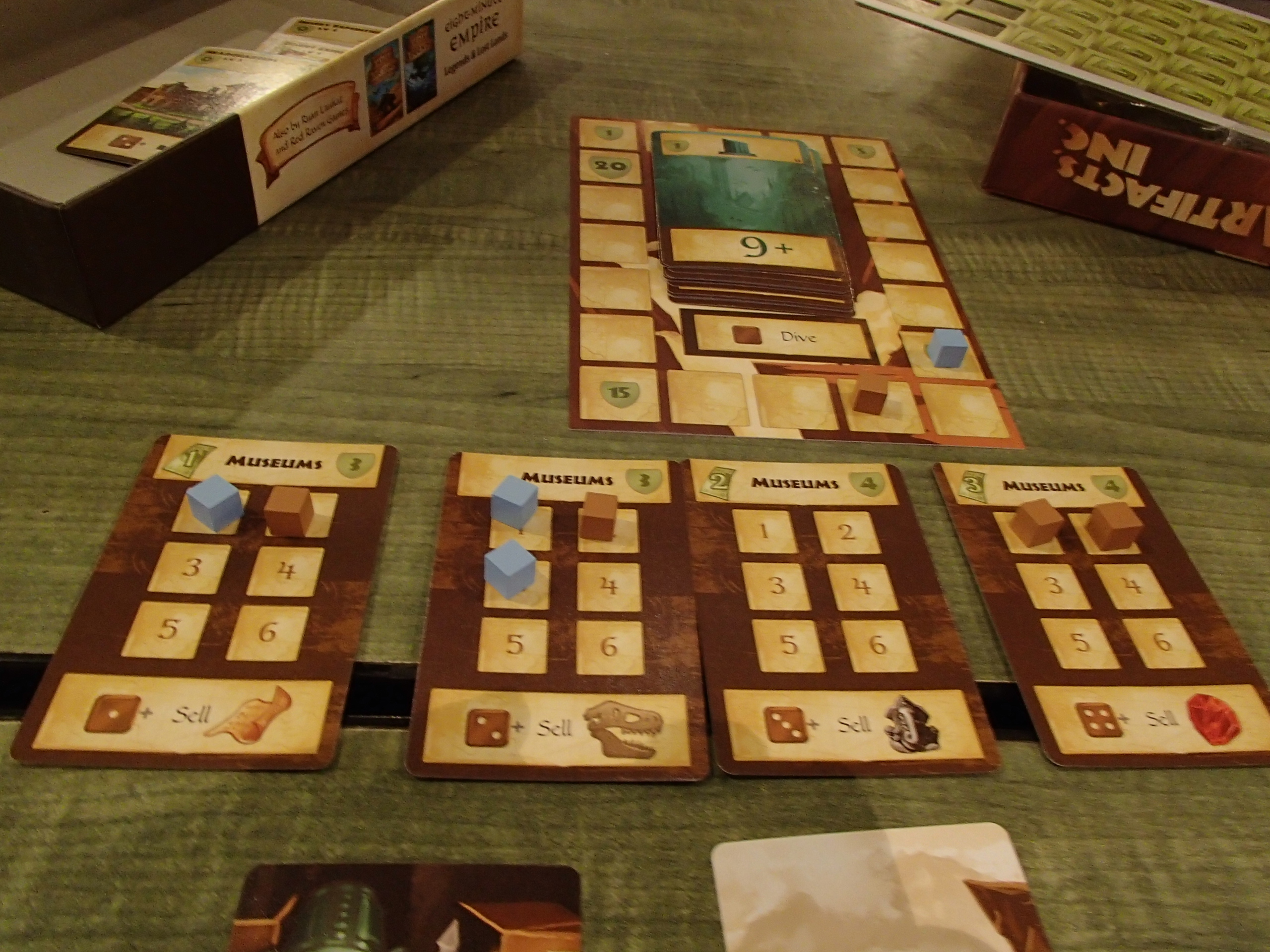| Publisher | Red Raven Games |
| Design Credit | Ryan Laukat |
| Art Credit | Ryan Laukat |
| Game Contents | 48 Wooden Cubes (in 4 colors), 72 Cards, 1 Reputation Board, 35 Dollar Tokens, 7 Dice, Rulebook |
| Guidelines | Relic collection and sales in 1929 |
| MSRP | $24.99 |
| Reviewer | Andy Vetromile |
Imagine the excitement of being Indiana Jones, or pursuing relics of the ancient past like Howard Carter or Zahi Hawass. Now imagine being the guy who funds and manages all their expeditions. You’re in charge of Artifacts, Inc.
The object is to amass the most Reputation Points.
Two to four entrepreneurs hire teams of adventurers and begin dealing in pieces of the past for points. A player has cards representing his archaeologists’ stomping grounds, some wooden cubes in his player color, and a little starting cash. His employees are six-sided dice, and the player rolls his workers to see what he – they – can accomplish on his turn. Cards are rated for how many six-sided dice they accept and the value needed to use them, while additional cards are purchased from a selection in the middle of the table. For example, Mountain Expedition has a space for “5+,” so if a player has a die showing five or higher he can assign it to activate that card.
A worker may be tasked with buying things from the big spread on the table or upgrading a card already in one’s display – most are double-sided with improved statistics on the opposite face, offering more money, points, or powers. These improvements require money, usually gained by sending a worker to guide tours or sell valuable discoveries. The game isn’t won with money, though, so it’s better in the long run to foist one’s finds off onto proper museums. Players dedicate workers to Museums cards like any other, placing dice and his colored player cubes there to indicate he has “donated” the relics associated with that card. For example, a Canyon Expedition produces Fossils and a player uses his cubes to represent how many Fossils he’s found. There’s a Museums card for each artifact type, and selling one’s wares to it occupies a numbered space: The aforementioned hunter could turn in and sell two of his Fossil cubes to the Fossil Museums card, thereby occupying space 2 with one of those colored cubes. The player gets money and Reputation from the institution, and whoever places the most cubes on each Museums card gains additional points later.
Adventurers can amass research vessels, start expeditions to the mountains, hire new personalities to manage their affairs, and more, but everything must fit into two rows in their play area. There’s not much limit to where they can build, but cards can’t be moved once placed and some cards offer benefits – usually in the form of additional Reputation Points – for being adjacent to other, related cards. And lest it seem everything here is an academic concern, the adventurers do, in fact, get to go adventuring. By taking the Dive action a player can combine dice to buy the top card of the Dive deck. As these are bought, the “purchase” price – in dice pips – goes up. They score points and work with other cards for bonuses, though, so it can be worth it. This continues until someone triggers the endgame with 20 Reputation Points; play ends and “hidden” points are counted to determine a winner.
Artifacts, Inc. is almost entirely cards, but they’re fairly nice cards. Designer Ryan Laukat pulls double duty on the art and look of the cards, and while some of them are simple illustrations the situational and landscape portraits he provides are above what you expect to see in a game. The counters are solid cardboard and the dice are small – and roll an annoyingly long time – but nice.
There’s a lot packed into the modestly sized box and almost all of it is something to like. Artifacts, Inc. is a well-balanced and cleverly interconnected set of mechanics. Players have multiple options to explore for success – in fact, they’ll be a while exhausting them, which keeps the game fresh for a lot of replay. Tradeoffs between money and points are nothing new in games but they’re played to excellent effect here, with the spread of cards on sale tempting players like kids in a candy store deciding what to buy. (And with many cards comes great space requirements – this isn’t a small game once it unfolds.)
Everything on offer here brings out the theme during play and reinforces the metaphor nicely. Tripping someone up mid-strategy is still likely, if for no other reason than that folks find the same things to be tempting targets for purchase. Even so, once someone secures something ahead of you there’s always a Plan B – one must simply change the focus of one’s in-game engine. Artifacts, Inc., a find in and of itself, plays quick, maintains its motif, and ultimately satisfies.



